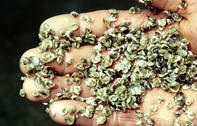Pacific oysters, the most widely farmed oyster species, can be produced in land-based, estuary or offshore-based production systems. In South Africa, the bulk of oysters are produced in offshore-based mariculture farms.

There is, however, a land-based oyster farm in Kleinzee, which produces oyster seed, and a small government-run oyster farm, using oyster racks, was established in the Keiskamma estuary.
The long-line system is widely used in South Africa oyster farms. Seed oysters, also called ‘spat’, are stocked into lantern nets, which are spaced 1,5 m away from each other. These nets are suspended from floating long-lines, which are anchored to mooring blocks.
The Oyster Farming Process
Basically, the process of farming oysters consists of four stages:
Larval rearing and spat production is the first stage. In South Africa, the most oyster spat is imported from Guernsey, Chile, Europe, Namibia or the United States. Small quantities of spat are also produced in Kleinzee, in South Africa’s Northern Cape Province.
The second stage is the nursery rearing of spat from 1 - 15 mm.
The third phase is grow-out from juvenile to harvest size.
The final stage is conditioning and grading. Grading the size of oysters is done throughout the production, from spat size to final harvest.
Nursery stage:
The purpose of oyster nurseries is to rapidly grow small oyster seed or ‘spat’ for transfer to grow-out trays, bags or nets with mesh apertures of 7 - 12 mm.
Spat can be bought at about 2.5 - 3 mm but this results in a long grow-out time. Better grow-out times are achieved using Chilean spat, bought at 7 - 12 mm size. These seed oysters are held in floating crates, through which water is pumped in an upward motion. This is process is called ‘upwelling’ and results in fast growth, oysters can grow to 15 - 20 mm in three to four months. Oysters are filter feeders and extract plankton from seawater.
When oysters reach about 20 mm they are transferred to nets suspended on floating longlines in open seawater in sheltered bays. Every six weeks oysters are inspected and size graded to ensure even sizing of oysters in each growing net.
Depending on the water conditions, oysters can reach marketable size (cocktail size) in 10 - 12 months.
Because oysters are filter feeders, contaminants may concentrate in the oyster’s flesh. During a post-harvest process called conditioning, oysters are kept in tanks of purified seawater for at least three days to eliminate possible contaminants by maximising their natural filtering activity.
After conditioning, oysters are inspected and packed into polystyrene boxes and kept cool with gel packs or ice bottles before being transported. The cool chain is maintained at between 4 and 8℃.
Oysters and Water Quality
Oysters can act as water quality indicators, due to their ability to filter toxins and microbes from the surrounding water. As most oyster farms in South Africa are located close to land in sheltered bays, the discharge of municipal effluent water into the ocean is a potential threat to water quality and the health of oysters.
Water quality in oyster farming is extremely important and are rigorously tested, up to twice a week according to John Rice from the Knysna Oyster Company. In South Africa, oyster farms are required to weekly sample oysters and water in the culture area.
These are tested in accredited laboratories, as part of the South African Molluscan Shellfish Monitoring and Control Program (SAMSM&CP). This program is administered by the Department of Agriculture, Forestry and Fisheries (DAFF). Tests include microbial analyses (e.g. E. coli and Vibrio) and testing for heavy metals, e.g. mercury.
By Marinda Louw